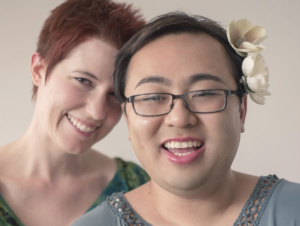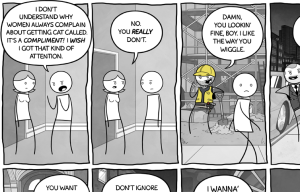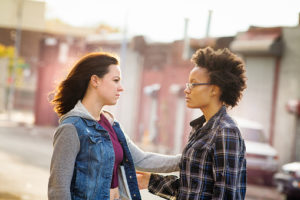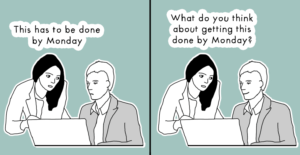
Credit: Pave
On every single college campus in the United States, there is a powerful, committed group of feminists and feminist allies who are working to prevent sexual violence and respond to the needs of survivors.
These incredible coalitions of students, professors, staff, administrators, and wider community members are working every single day to ensure that survivors have the support they need while working to prevent further sexual assaults.
Too often, though, they are working against institutions and campus environments that shame survivors, protect perpetrators, and reinforce the rape culture that is endemic in our society.
The grim reality is that at least 1 in 4 college women are survivors of sexual violence, and our institutions are not doing enough to stem this terrible tide.
It is time that more of us join these committed activists in transforming the culture and climate of our college and university campuses.
Whether you’re a parent, a student, an alumni, or simply a concerned community member, here are a few ways that you help:
1. Change How We Talk About Sexual Violence
The messages that are sent to women and men about sexual violence on college campuses tend to be misguided at best and downright dangerous at worst.
Whether the message is delivered formally through a New Student Orientation program or through norms and mores, the traditional wisdom for sexual violence prevention on college campuses can often be boiled down to:
“Ladies, be careful so you don’t get raped.”
Whether we tell women to go out in groups, watch their drinks, or never walk across campus alone at night, the conversation is the same – the responsibility for preventing sexual violence is on women.
But considering that the VAST majority of rapes are committed by men, we can’t afford to leave men out of the conversation!
To place the responsibility for sexual violence prevention on women not only completely ignores those who perpetrate the majority of sexual assaults, but it lends itself to victim blaming.
“You shouldn’t have been dressed that way.” “You shouldn’t have gone out alone.” “You shouldn’t have been drinking.”
Thus, in both our informal conversations and as we look to change how our institutions address sexual violence, we must shift the conversation to ones of positive sexuality, enthusiastic consent, healthy masculinity, and support for survivors.
First, if sex and sexuality is talked about openly and honestly, we can begin to have more accountable conversations regarding positive sexuality.
We can introduce the ideas behind and methods for realizing enthusiastic consent. We can encourage healthier relationships and healthier sexuality in all their forms. So that people of all genders understand what healthy and consensual sexual relationships can and should look like,
Secondly, we must also end the culture of male sexual entitlement, disrespect, cat calling, and objectification that protects perpetrators of sexual violence.
Men, women have been trying to tell us these things for ages. It’s time for us to be the leaders in ending sexual violence. We, as men, need to work with other men to change how we talk about and practice sex.
Third, we need to change how we talk about sexual violence so that it reflects reality and not myths about rape.
A good place to start is changing where we place the onus for prevention. The only person responsible for a sexual assault is the perpetrator. Plain and simple. From there, we can do a better job of supporting those who experience sexual assault.
Finally, we have to make sure that our conversations don’t accidentally silence survivors who don’t fit our understanding of “normal.” Any person of any gender or any sexual orientation can experience sexual violence. 50% of transgender people experience sexual violence and approximately 8% of all men (by conservative estimates) are raped by a former partner.
Often, conversations around rape focus solely on straight relationships, but lesbian, gay, and bisexual people commonly experience sexual violence too. Further, 1 in 10 survivors of sexual violence are men, and we need to have resources that support male survivors.
Lastly, we need to expand the conversation around sexual violence beyond rape (forced sexual intercourse, including vaginal, anal, or oral penetration) to other types of unwanted sexual contact and coercive sexual activity (including forced kissing, groping, forced hand jobs, non-consensual kissing, etc).
Otherwise, those who experience sexual violence that they would not call rape may feel like their experience is not legitimate or worthy of attention. But they often still experience trauma like rape survivors because it was still not consensual.
In short, we can make our conversations more inclusive, and we can push to make our campus programming more inclusive.
2. Transform Party Culture
A tremendous number of sexual assaults take place during or after college parties. Does this mean that parties are evil? Obviously no, but it does beg certain questions about how we can make our parties more sex positive and preventative of sexual violence.
4 in 5 college students drink, and about half of college drinkers engage in heavy binge drinking while attending college parties. While alcohol surely doesn’t cause sexual violence, alcohol consumption is a common factor that facilitates sexual violence.
According to one study, 74% of people who have committed sexual violence were under the influence of alcohol when they did it, and 55% of survivors were under the influence of alcohol when they were assaulted.
Now, we must be careful in discussing the link between alcohol and violence because we are not implying that anyone who drinks somehow brings sexual violence on themselves.
But let’s be real – people who set out to commit rape use alcohol to incapacitate their victims in a strong majority of their assaults.
So what are we to do? Well, the solution is definitely not to call for some kind of new temperance movement or simply to tell women to watch their drinks.
Instead, researchers A. Ayers Bowell and Joan Z. Spade identify characteristics of parties that are higher risk for sexual violence in contrast with parties that are of lower risk for sexual violence.
For example, parties where drinking is more casual, with less alcohol consumed over more time, are linked to fewer assaults than parties where binge drinking is the norm.
Parties where there is a tolerance for jokes, conversations, and behavior that degrades women are of higher risk, but parties where there is a lot of conversation and respectful socialization between men and women are linked to lower rates of sexual violence.
In short, if we make our parties more sex positive and respectful while encouraging responsible drinking, we can throw parties that are not only tons of fun but that are preventative of sexual violence.
3. Believe and Support Survivors
One of the many roles of sexual assault survivors’ advocates is to listen to survivors, believe and affirm their story, and help them understand what they need to heal.
Rarely, though, do survivors choose to publicly discuss their experience or press charges, either legally or within the disciplinary system of their college or university.
And why would survivors want to publicly acknowledge their assault? Often when survivors do, they are treated both socially and institutionally as if they are lying or as if they somehow did something to deserve the assault.
Unfortunately, whether they are seeking legal justice or a school disciplinary response, pressing any sort of charges is likely to be hell for the survivor. They will have to tell their story over and over, and they will be put on public trial, being accused of dressing or acting in a way that invited assault.
But we don’t need to stand for this. One of the most sustaining aspects of rape culture is its ability to silence survivors for fear of this type of treatment. In order to change this, we have to speak out in support of survivors, believe and affirm survivors when they share their stories, and hold people accountable to their words and actions.
When someone says something that shames or blames survivors, more of us must speak out. When someone acts to objectify or disrespect women, more of us must speak out.
Men must transform our relationships with other men to be ones of positive masculinity and healthy sexuality. People of all genders must work in coalition to end the silencing and to expose rape culture everywhere it exists.
This seems simple, but we need more people to join us in this struggle.
4. Focus on Prevention Too
Most institutions do have some sort of sexual violence response protocol: counseling services, advertised hotlines, health services, peer advocates, and disciplinary actions (though it rarely gets that far).
Setting aside the varying effectiveness of these response protocols, these services are vitally important for supporting survivors.
The problem, though, is that they are limited. They quite necessarily focus on responding to sexual violence once it has happened. While this is important, it’s not enough.
We must continue to demand that our institutions invest resources and attention toward prevention.
In my work, I often reach out to colleges and universities in hopes of connecting with those on campus responsible for sexual violence prevention. Far too often, though, I am told, “We don’t really have someone responsible for that. Do you mean counseling services?”
With endless research-driven approaches, resources, programs, and trainings that focus on primary prevention, there are countless viable ways that we can be engaging in prevention work on our campuses.
But this takes a financial and comprehensive commitment from the institution. We all know how hard it is to ensure new financial commitments (no matter how small) in the era of belt tightening and budget cuts.
But if enough members of our communities are demanding it, our administrators will have no choice but to listen.
5. Demand More Supportive and Responsive Institutions
The other side of ending rape culture involves addressing how our institutions respond to sexual violence.
In 2012, AmherstCollege was rocked by a sexual assault scandal. Angie Epifano was raped by another student while attending Amherst. When she sought help through the college’s counseling services and her dean, she was told to simply get over it and move on.
The college, a highly-respected liberal arts institution, literally did every single thing wrong that it could possibly do, and when Epifano shared her story publicly, numerous other survivors came forward with similar stories.
It’s sad that it took a survivor publicly sharing her story like this in order to force an institution to change. But if there’s any silver lining in this terrible tale, it’s that Amherst’s president, Biddy Martin, didn’t shy away from responsibility.
She acknowledged that Amherst had failed its students, particularly its student survivors, and she vowed to make the college a national leader in sexual assault prevention and response.
Since that time, the institution has committed itself to improving counseling services, expanding prevention efforts, and to listening to feminist activists who have been calling for changes for decades.
Amherst is simultaneously an example of the terrible ways in which academic institutions often respond to sexual violence on their campus AND of the powerful changes that can take place in how institutions respond to this violence.
Moving forward, we must ensure that it doesn’t take more trauma like that which Epifano experienced to force our institutions to change.
We Must Rise
Ask any committed activist: transforming our institutions will not be easy.
It will take coalitions of people of every race, religion, ability, gender, sexual orientation, citizenship status, and level of wealth.
It will take coalitions of students, professors, parents, staff, administrators, and community members.
But the beauty is that we already have powerful leaders and models from every one of these areas of our communities.
We have activists and advocates and allies who need our help. Our institutions can only marginalize our voices if we’re fractured and disparate.
We must rise.
***
Obviously one article can’t highlight all of the ways that we can transform our institutions or all of the challenges we face, so please leave your suggestions and insights in the comments.
[do_widget id=”text-101″]
Jamie Utt is a Contributing Writer for Everyday Feminism and a diversity and inclusion consultant and sexual violence prevention educator based in Minneapolis, MN. He lives with his loving partner and his funtastic dog, Chloe. He blogs weekly at Change From Within. Learn more about his work at www.JamieUtt.com. Follow him on Twitter@utt_jamie.
Search our 3000+ articles!
Read our articles about:
Our online racial justice training
Used by hundreds of universities, non-profits, and businesses.
Click to learn more




















